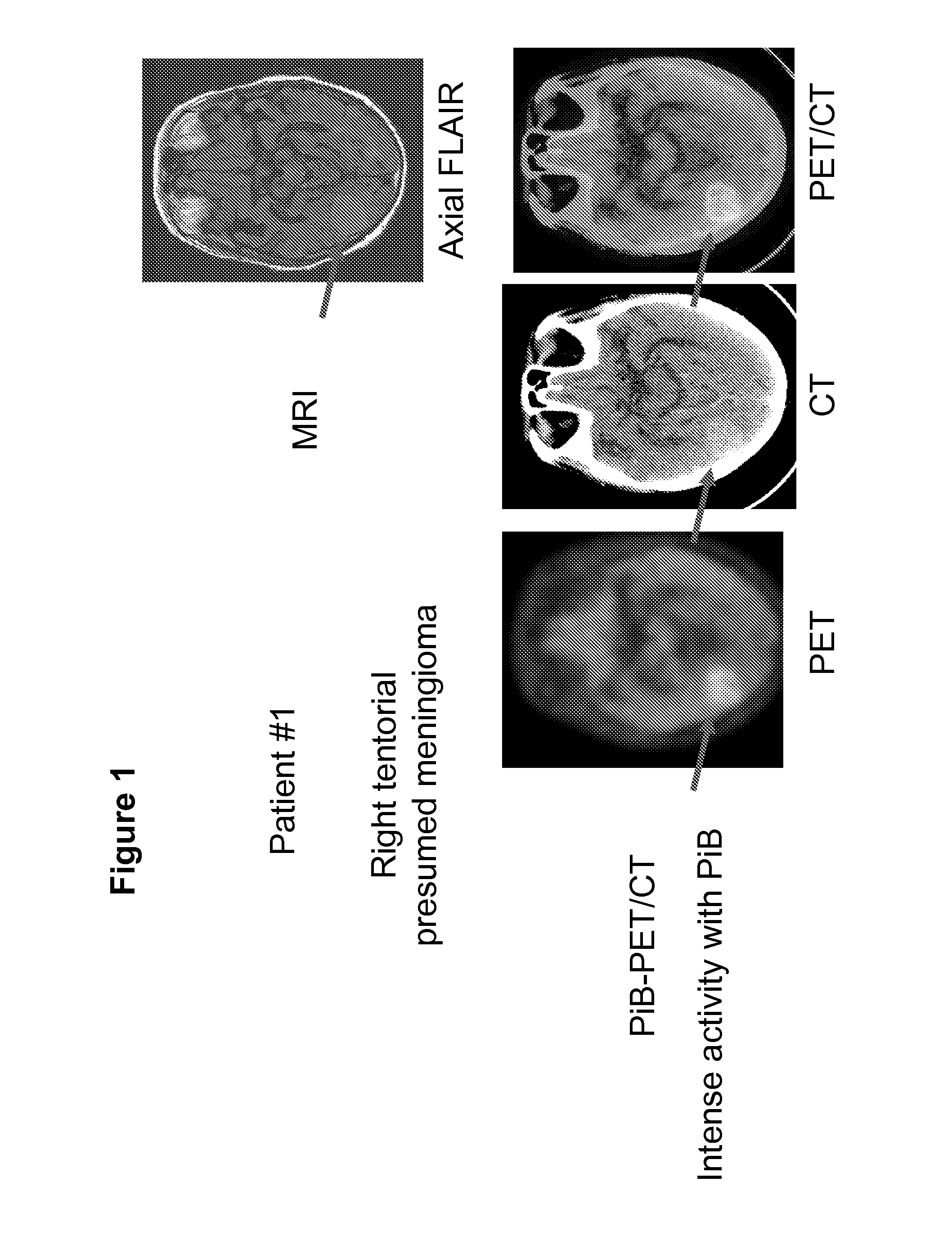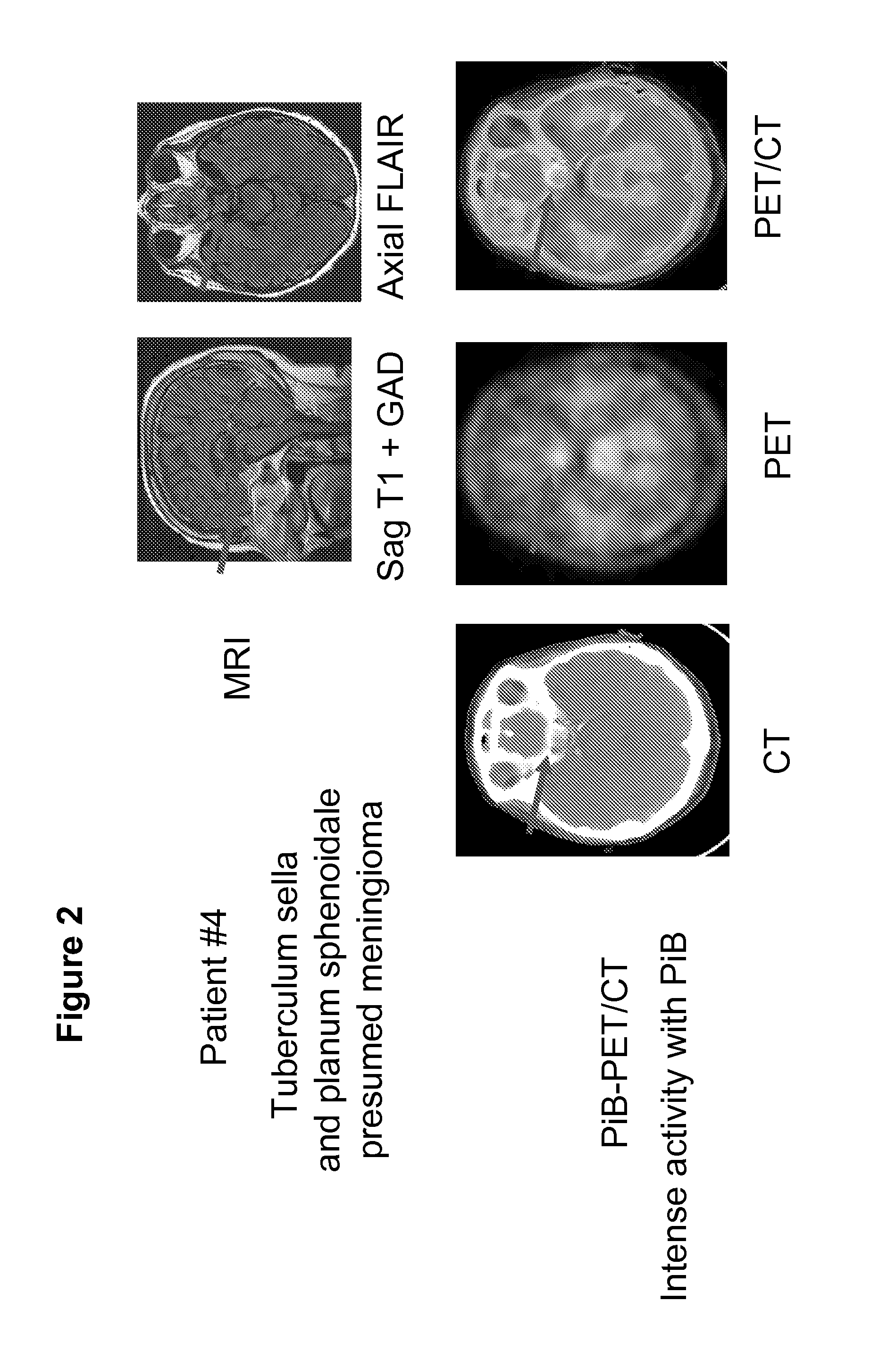Imaging of meningiomas using phenylbenzothiazole, stilbene, or biphenylalkyne derivatives
a technology of phenylbenzothiazole and phenylalkyne, which is applied in the field of meningiomas imaging using phenylbenzothiazole derivatives or stilbene derivatives or biphenylalkyne derivatives, can solve the problems of lack of confidence in conventional diagnostic imaging, dramatic and negative effects on patient medical care, and lumbar puncture with cerebrospinal fluid testing is not useful for diagnosing meningiomas
- Summary
- Abstract
- Description
- Claims
- Application Information
AI Technical Summary
Benefits of technology
Problems solved by technology
Method used
Image
Examples
example 1
[0080]An Alzheimer's imaging database of two hundred forty-one patients was reviewed. Some of the patients had a history of cognitive impairment that might be due to early Alzheimer's disease and some were normal controls. All patients had been imaged by at least one MRI, as well as by FDG-PET / CT and PET / CT using the compound of formula (V). MRI reports of all patients were reviewed for possible meningiomas and other tumors. Seven patients were found to have the diagnosis of presumed meningioma based on MRI and sometimes also on CT. The diagnostic confidence of the radiologists interpreting the studies varied slightly, depending on factors such as tumor location and previous imaging. Of these seven tumors, six showed intense uptake of the compound of formula (V) on PET / CT. One showed some uptake, but was difficult to evaluate presumably because of its small size (˜4 mm. thick). Tumors smaller than 7 millimeters are generally considered too small to be evaluated by PET or PET / CT. Thi...
example 2
[0083]In Example 1, we identified six patients with meningiomas >5 millimeters in size that showed positive uptake of the compound of formula (V) on PET / CT. We identified three more patients with four presumed meningiomas. All three patients were imaged by PET-CT using the compound of formula (V), FDG PET-CT and MRI within as part of the ongoing amyloid imaging study. In one patient, there are two meningiomas. One is in the orbit, and is therefore extracranial. This orbital meningioma was previously resected and pathologically shown to be a meningioma in 1969, and pathology was confirmed later at our institution. It has now regrown within the orbit. The other meningioma is along the falx. Both show avid uptake of the compound of formula (V). There were two other patients with a single meningioma with uptake of the compound of formula (V). Therefore, there are a total of ten presumed meningiomas that show uptake of the compound of formula (V) on PET / CT.
example 3
[0084]In Examples 1 and 2, we identified ten patients with meningiomas >5 millimeters in size that showed positive uptake of the compound of formula (V) on PET / CT. We identified three more examples of presumed meningiomas that show activity using the compound of formula (V) on PET-CT, for a total of thirteen. All of these formula (V) avid meningiomas are >5 millimeters in size. We also identified three more presumed meningiomas that showed some positive uptake of formula (V), but were non-diagnostic due to common limitations of PET / CT imaging. One of these non-diagnostic presumed meningiomas was too small to evaluate by PET or PET / CT. One of these non-diagnostic presumed meningiomas was necrotic / cystic centrally with a 4 millimeter rim of tumor, and is therefore effectively also too small to evaluate by PET or PET / CT. The other of these non-diagnostic presumed meningiomas was only seen in the last 2 slices of PET data, an area considered to be uninterpretable. In addition, this pati...
PUM
| Property | Measurement | Unit |
|---|---|---|
| volume | aaaaa | aaaaa |
| size | aaaaa | aaaaa |
| size | aaaaa | aaaaa |
Abstract
Description
Claims
Application Information
 Login to View More
Login to View More - R&D
- Intellectual Property
- Life Sciences
- Materials
- Tech Scout
- Unparalleled Data Quality
- Higher Quality Content
- 60% Fewer Hallucinations
Browse by: Latest US Patents, China's latest patents, Technical Efficacy Thesaurus, Application Domain, Technology Topic, Popular Technical Reports.
© 2025 PatSnap. All rights reserved.Legal|Privacy policy|Modern Slavery Act Transparency Statement|Sitemap|About US| Contact US: help@patsnap.com



